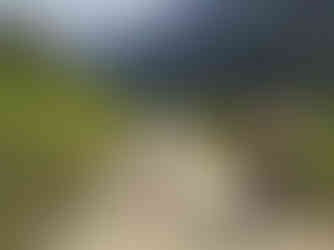OCTOBER 2019
Of all the things and places we wanted to see on our trip, the Annapurna Circuit was one of the sure things: A trek that goes over the 5416m high Thorong La (Pass). The majority of the hikers does this trek from Besisahar to Muktinath by foot, some on a guided full-suspension-MTB tour and then there are a few who have the idea of doing the whole thing self-supported with their touring bikes. Because of @gone.bikepacking and @ecornelis we got inspired to do it like that as well - thanks guys!

Stage 1 and 2, Pokhara to Begnas Lake to Besisahar (total 83 km & 1750 m elev. gain)
As it's called 'circuit' it was clear to us that we're going to try riding it from and to Pokhara, the whole loop. Knowing that there are parts of the trek where we'd have to push our bikes, we tried to go as light as possible and left all unnecessary stuff in Pokhara. After quite a long break from riding we set off for an easy first day to Begnas lake where we found a basic but nice homestay. The second day was much longer and harder because the surface changed to the infamous Nepali dirt-dust-flour-whatever thing sometimes also called 'tarmac nepali style'. We reached Besisahar quite exhausted, but totally ready and excited for the next few days.

Stage 3, Besisahar to Syange (26 km & 825 m elev. gain)
The Annapurna Circuit officially starts in Besisahar where we had to show our ACAP permit and shortly after the TIMS card for the first time. Both permits are mandatory if you want to trek or ride in the Annapurna Conservation Area. There's a rough jeep track from Besisahar to Manang running parallel to the hiking trail. We had no idea what to expect from it, but having done a few km, we realized that some though challenges were ahead of us. The gradients changed constantly and so did the surface: from mud to sand and dust, from super smooth to super rough with big stones. Oh, and there were some river crossings and suspension bridges, too. Our bikes (Beyond 1 by @bombtrackbicycleco) are made to handle rough stuff and did so really well, but sometimes all we could think of was: Give me some suspension! Give me wider tires!! We arrived in Syange and stayed in a nice lodge next to the river where met people, we would run into again and again in the upcoming days. Two big portions of Dal Bath (each) made for a good end to this day.

Stage 4, Syange to Dharapani (22,5 km & 1070 m elev. gain)
You know you're really hard to find when the gps signal on your device jumps around like crazy because it lacks connection to a satellite. This happened as we climbed higher towards the small village of Dharapani. It was definitely one of the most spectacular, but also scariest sections so far. Overhangs, cliffs, landslides, shooting stones, impressive waterfalls and river crossings; again, there was just everything. Even a stretch of fine tarmac. We reached the lodge where we'd spend the night quite early and got to chat with it's owner for a while, since we were the only guests. Compared to previous days temperatures dropped quite fast once the sun had disappeared: We could easily tell that we had gained some elevation that day. Luckily we had brought our sleeping bags, which were waiting for us in a small, cozy, wooden room.

Stage 5, Dharapani to Chame (19 km & 1000 m elev. gain)
On our previous trek to the Annapurna base camp, we were stopped a few times by children who naturally asked us about: "Sweets?! Chocolate! Money!!!". We always refused very firmly, on the one hand because we were annoyed by the sometimes very demanding and cheeky nature of the children, on the other hand because guidelines on the behaviour of tourists in the Annapurna Conservation Area advise against it. ⠀⠀⠀⠀⠀⠀⠀⠀⠀⠀⠀ Also on the way from Dharapani to Chame we were greeted joyfully by 2 boys at the roadside and got involved in a conversation. They had set up a small stall and sold popcorn and dried fruits. It was very difficult to tell if they were just earning pocket money or improving the family's income instead of going to school. We bought something from them, knowing that this was perhaps just as questionable as giving something to begging children, as it encouraged them to continue. We have no answer to the question whether it is better to support begging children or working children. But what we have once again become aware of is how privileged we are in our position as bikepackers aka. tourists and how difficult it is sometimes to reconcile our Western view of things with everyday life in other countries and cultures.

Stage 6, Chame to Lower Pisang (16 km & 690 m elev. gain)
During our time in the Himalayas (and the Kyrgyz mountains) we notoriously sticked to one important rule to prevent altitude sickness: If you go above 2,500 metres you should increase your altitude by only 300 to 400 meters a day (you can climb more than 300 meters in a day as long as you come back down and sleep at a lower altitude). ⠀⠀⠀⠀ ⠀⠀⠀⠀⠀⠀ That is why our stage from Chame to Lower Pisang was a pretty short one. After a delicious and strong (real!!!) coffee at the @dailycaffeinehouse where we restocked on grounded coffee for our bialetti we started riding into cold, cloudy weather with some drizzling rain from time to time. It was an easy day on the bike and we enjoyed the views: Vegetation had already changed the day before and we were definitely not in the jungle anymore with conifers everywhere reminding us of the vegetation in the Swiss alps. ⠀⠀⠀⠀ ⠀⠀⠀⠀⠀⠀ As we arrived shortly after lunch Sara spent the afternoon reading a book in our wooden cottage while listening to Reggae Music and enjoying the good vibes at the 'Bob Marley Lodge'. And Andreas checked out some good trails on the opposite side of the valley, shredding down to the river without the bags attached to the bike.

Stage 7, Lower Pisang to Manang (16 km & 480 m elev. gain)
The prospect of eating cinnamon rolls and other sweets from a nice bakery is quite tempting when you have been on the road for some time so we were really looking forward to our stop in Manang. Manang is the biggest town on the way to the Thorong La and like most people, we planned to have a rest day in this beautiful Tibetan style village which lies on roughly 3500m asl.
The ride from Lower Pisang was maybe the most breathtaking we both ever encountered. White giants on both sides, blue skies, a perfect double track road combined with gentle gradients made it a pure bliss. Too bad this stage was only 20km long, we would have loved to ride on for hours. Still we were super happy reach this point of our trip and looked forward to a small acclimatization hike the day after.

Restdays in Manang
Actually, we had planned to take the very steep 'detour' to the Tilicho Lake after a rest day in Manang. We would have been hiking for two days, leaving our bikes at a lodge. But because Sara had problems with her Achilles tendon when we did a short acclimatization hike to over 4000 asl, we had to change our plan. So it was easy for our two Israelian friends, who we had met on the trek again and again during the last days, to convince us to a second rest day in Manang. Together we explored the village and its close surroundings, enjoyed the cosy get-together and, wearing shorts and t-shirts, filled up on sunshine thanks to perfect weather.

Stage 8, Manang to Yak Kharka (10km & 420 m elev. gain)
After a hearty breakfast and a last warm shower for the next few days, we set off from Manang to Yak Kharka. There were only 10km ahead of us, but it was the first stage of which we knew that we had to cope with some longer pushing passages: goodbye jeep-track, hello single trail! We now shared the trail with all the hikers, a few mountain bikers of a guided tour, locals and their horses, and an oncoming cyclist: @gerard.castella had just climbed Thorong La Pass from the other side and was in a bright and good mood, telling us what to expect. We kept running into hikers we had met before somewhere on the trek or in a shelter and cheered each other on. As the somewhat 'different' hikers, we of course enjoyed special status and were asked again and again about our 'two wheel trip'. We happily accepted the offer to be photographed with our own cellphones, because we don't really have pictures of the two of us riding our bikes (we are way too lazy for the self-timer thing... ). Upon arrival at the lodge in Yak Kharka we enjoyed a sunny and relaxed afternoon knowing that the next day would be a tough one.

Stage 9
Yak Kharka to Thorong La Base Camp aka. Thorung Pedi (6,2 km & 360 m elev. gain)
When we reached the teahouse at 5100m asl, it was 14:30. If we had not left our luggage at the Base Camp 600m further down the pass, we would have been very tempted to cross the pass that very day. But we were only there to store our bikes temporarily. It was really cold when we left Yak Kharka at 07:30 that morning. The sunrays had not yet reached that part of the valley and in some places the ground was frozen. Accordingly we were on our way fast and enjoyed the almost deserted trail, which however was mostly too steep or demanding to ride. Shortly before noon we were one of the first to reach the Thorong La Base Camp at 4500m asl and could therefore choose a particularly sunny room, which would hopefully be heated up until late afternoon. We refueled with coffee, rather expensive cinnamon rolls and porridge and resisted the temptation to spend the afternoon in the sun with our new friends @theyakandyeti and @arnogrj
Hike-a-Bike Thorung Pedi to Tea House and back (6,4 km & 550 m elv. gain)
We were on a mission: the ascent to the pass the next day would be hard, almost 1000m had to be climbed, of which the first 400m were very steep and stony. Therefore we wanted to bring our bikes to the High Camp the same day to make the start the next morning a little easier. But when we arrived at the High Camp, we learned from a local guide that there was the possibility to deposit the bikes even further up the mountain at a teahouse. Not hesitating, we hiked on. The trail was ours, weather conditions were perfect and despite the effort we still felt fit. So it happened that on this day we already got to know a big part of the trail, which we would walk again the next morning. After a warm tea we said goodbye to the friendly guy at the teahouse and our two bikes and walked back down to the Base Camp.

Stage 10, Thorong Base Camp to Thorang La Pass to Kagbeni (30 km & 900 m elev. gain)
Goosebumps! People cheered at us when we rode the last meters to the pass: "Thorang La WITH YOUR BIKES, congrats!" It really felt like a huge success! 10 days before we had started in Pokhara on 900m asl and were now at 5416m asl, the highest we had ever climbed in our lifes. When people asked us the days before, if we were going over Thorong La, we answered: 'Well... Yeah, we try to... '. Altough everything went according to plan and we always felt good, we knew that altitude sickness could strike anytime and force us to descend again. So even when we were at the teahouse again that morning to collect our bikes we had dropped the day before we weren't sure we'd really make it. Descending towards Muktinath wasn't only fun: the single track was quite challenging and we had to walk a lot. So it was all the nicer to ride from Muktinath to Kagbeni: 12km of perfect tarmac (and a descent of 800m) lay ahead of us. The crowning finale of an overwhelming day was dinner with our newly won friends @krystalbrownfield and @runswithbeer

Stage 11, Kagbeni to Marpha (17,3 km & 220 m elev. gain)
When we heard about an important Buddhist festival in the nearby village of Marpha during a coffee break, it was immediately clear that we would rather watch the festivities there than continue to ride on: The infamous headwind of the Mustang valley was hitting very hard. So we unexpectedly had a pretty easy day with a spectacular visit to the monastery and a relaxed afternoon in good company.

Stage 12, Marpha to Tatopani (42,6 km & 325 m elev. gain)
Down, down, down! The first 20km of relatively flat jeep track were an easy ride and once more we enjoyed breathtaking views. But after lunch in Kalopani the action really started: A never ending downhill from 2600m asl to 1200m asl back into the jungle followed. It was great fun to find the right line on the very rough and bumpy jeep track! Our arms and legs were probably just as challenged as our bikes. When we arrived in Tatopani the first activities of the upcoming Tihar Festival were taking place. The atmosphere in the village was great and as it darkened people were lighting candles everywhere.

Stage 13, Tatopani to Pokhara (102,7 km & 1840 m elev. gain)
We started late the next day as we thought that our penultimate stage would not be very long. We were wrong: Somehow, we just wouldn't stop riding as we could not find a decent place to stay overnight. Late in the afternoon we realized that we could make it back to Pokhara the same day if we were willing to ride in the dark.
People had warned us about the main road towards Pokhara: bumpy, dusty and overcrowded. But with Tihar, the festival of lights, going on, we were almost the only ones travelling as the locals were at home celebrating. Another reason to make it to Pokhara that day! We were moving fast and enjoyed it as it was fun to watch the festivities: families and communities were celebrating with loud music coming from speakers, there was dancing and chanting and of course nicely decorated and illuminated houses everywhere.
It was a long day, but somehow only began to hurt on the last few ascents before the final downhill into Pokhara where we arrived at around 10 pm - just in time to have a well deserved burger and beers before the place closed right after we left. Slowly, with everything that was happening around us, we started to realize: we and our very dusty bikes had just finished riding the Annapurna Circuit from and to Pokhara. BAM!




















































